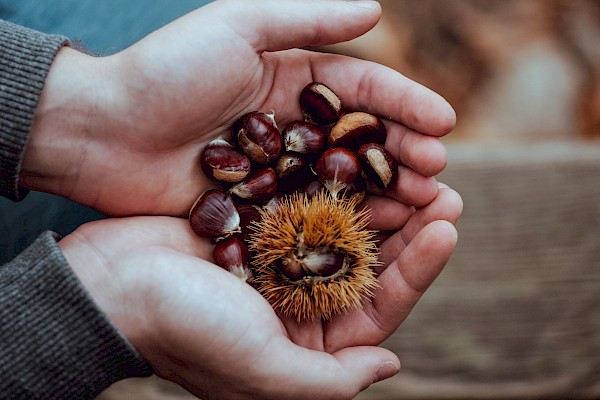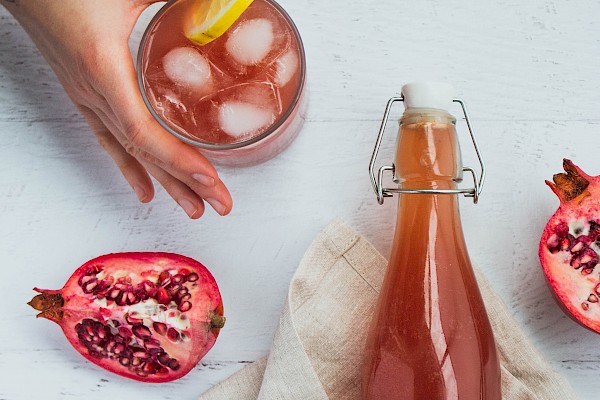Chocolate
We love chocolate in Switzerland, and we eat an average of approximately 10 kg per person per year. In 2020 we consumed a total of 85,860 tonnes of chocolate products. This makes our chocolate consumption the highest in the world. Are you a chocolate lover too?
“Nothing is better than a good friend, unless it is a friend with chocolate.”
– Charles Dickens –
Like Dickens, many people associate eating chocolate with feeling good. But is it really true that chocolate makes you happy? We want to answer precisely this question in this blog.
What is chocolate made of?
Chocolate has four basic ingredients: cocoa mass, cocoa butter, sugar and powdered milk. These ingredients can be mixed in different proportions, which is why there are three basic types of chocolate:
- White chocolate: cocoa butter + sugar + powdered milk + vanilla or vanillin
- Milk chocolate: cocoa mass + cocoa butter + sugar + powdered milk + vanilla or vanillin
- Dark chocolate: cocoa mass + cocoa butter + sugar + vanilla or vanillin
As you can see, white chocolate does not contain any cocoa mass and dark chocolate contains no powdered milk. So not every type of chocolate is made from the same ingredients. The three basic sorts are used as the base for making other varieties of chocolate. If you would like to learn more about the history and production of Swiss chocolate, you can find more information here.
Cocoa mass and cocoa butter are produced from cocoa beans, which are extracted from the seeds of the cocoa plant. The beans contain important substances such as fats (cocoa butter), minerals (potassium, magnesium), vitamins (A, B1, B2, C, D, E), trace elements (iron, phosphorus), flavanols, phenethylamine, tryptophan and methylxanthines (theobromine, caffeine).
How does cocoa affect our bodies and health?
The different substances in cocoa can act on your body in different ways. A few are listed below. As white chocolate is made without cocoa mass, it doesn’t contain any of these substances.
Flavanols
Flavanols are antioxidants and members of the flavanoid family. That means that they protect our bodies from oxidative stress. It is assumed that oxidative stress is involved in diseases of the immune system or even the development of cancer. Research has likewise shown that cocoa can change intestinal flora in the same beneficial way as pre- and pro-biotics. However, the data on this are not unequivocal.
Flavonoids are not just present in cocoa, but also in other foodstuffs such as fruits, vegetables, tea and red wine. They are also what gives chocolate its bitter flavour. This means that dark chocolate contains more flavanols.
Methylxanthines
Caffeine and theobromine are among the methylxanthines found in chocolate (or rather in cocoa). Theobromine acts in a similar way to caffeine; they both have generally stimulating properties. Theobromine acts as a vasodilator, which means it opens the blood vessels. It also boosts the heart’s pumping capacity, relaxes the bronchial tubes, increases stomach acid secretions and stimulates kidney function. In high concentrations, it can also trigger a state similar to intoxication. Theobromine is one of the main active substances in chocolate. The more cocoa mass chocolate contains – that is, the darker it is – the higher the concentration of caffeine and theobromine.
Tryptophan
Tryptophan is a component that the body needs to make the neurotransmitter serotonin. Serotonin affects both our mood and our sleep. People with depression are often lacking in serotonin, so it is also used to treat depression.
Phenylethylamine
Phenylethylamine causes blood sugar levels to rise, and also stimulates the central nervous system. With theobromine, it is the main active substance in chocolate.
It seems that chocolate also has positive effects on our bodies and our health, thanks to the cocoa. However, this depends very much on what sort of chocolate you consume, because not all chocolate varieties have a high cocoa content. As you have just read, white chocolate, for example, contains no cocoa mass and the cocoa content can vary hugely in other sorts of chocolate too. You can quickly find out how much cocoa your favourite chocolate contains by looking at the packaging.
Does chocolate make you happy, or not?
Most varieties of chocolate only contain a small quantity of cocoa. For example, popular milk chocolate only contains approximately 30 percent cocoa. That is why the concentration of beneficial substances – that potentially make you happy – is very low. The ingredients in chocolate alone don’t boost your mood or make you happy. However, studies show that eating chocolate may enhance the mood. How can this be, when the ingredients can’t be responsible, because the quantities are too small? What are the possible other factors?
Until now there have only been a few experimental trials, which makes it hard to answer this question. However, eating in general is bound up with the moods and emotions. In connection with chocolate consumption, there are indications that eating chocolate is associated with pleasant childhood memories. For example, you may recall celebrations like Easter, birthdays or Christmas when eating chocolate. In addition, it contains fat and sugar, which activate the reward system in our brains, resulting in a pleasant, happy feeling. However, you should not forget that most chocolate is very high in sugar. Sugar harms our bodies and can also negatively affect our minds if consumption is high. Therefore, if you eat a lot of chocolate, and consequently a lot of sugar, it could be that chocolate is actually making you unhappy. If you want to learn more about sugar, then we recommend our blog post “Sweet as sugar”.
Conclusion
The ingredients of chocolate don’t make you happy in themselves, because they are mostly present in quantities too small to have any effect. Nevertheless, eating chocolate can boost your mood. Science presumes that the reason is a combination of several factors: the positive childhood memories you associate with chocolate, the flavour experience, the activation of the brain’s reward system, and the ingredients. Studies also show that chocolate only improves your mood if you deliberately eat the chocolate and enjoy it. This means that you can yourself influence how chocolate makes you happy by consciously and appreciatively eating chocolate – in moderation, of course!
References:
Chocosuisse. (2008). CHOCOLOGIE Geschichte und Gegenwart der Schweizer Schokoladeindustrie. 1-62. https://www.chocosuisse.ch/services/unterrichtsmaterial
Chocosuisse. (2020). Facts & Figures. https://www.chocosuisse.ch/services/facts-figures
Franco, R., Oñatibia-Astibia, A., & Martínez-Pinilla, E. (2013). Health benefits of methylxanthines in cacao and chocolate. Nutrients, 5(10), 4159-4173. https://doi.org/10.3390/nu5104159
Max Havelaar-Stiftung Schweiz. (2021). Kakao. https://www.maxhavelaar.ch/fileadmin/CH/Mediathek/Factsheets/Factsheet_Kakao_d.pdf
Meier, B. P., Noll, S. W., & Molokwu, O. J. (2017). The sweet life: the effect of mindful chocolate consumption on mood. Appetite, 108, 21-27. https://doi.org/10.1016/j.appet.2016.09.018
Merlot, J. (2015, May). Macht Schokolade glücklich? Spiegel Gesundheit. https://www.spiegel.de/gesundheit/ernaehrung/macht-schokolade-gluecklich-mythos-oder-medizin-a-1029781.html
Open Science - Lebenswissenschaften im Dialog. (2019, April). Macht Schokolade wirklich glücklich? https://www.openscience.or.at/hungryforscienceblog/schoko/
Rehberg, C. (2021, October). Dunkle Schokolade ist gesund. Zentrum der Gesundheit. https://www.zentrum-der-gesundheit.de/ernaehrung/lebensmittel/schokolade/dunkle-schokolade
Römer, G. (2012, September). Theobromin. DocCheck Flexikon. https://flexikon.doccheck.com/de/Theobromin
Veronese, N., Demurtas, J., Celotto, S., Caruso, M. G., Maggi, S., Bolzetta, F., Firth, J., Smith, L., Schofield, P., Koyanagi, A., Yang, L., Solmi, M., & Stubbs, B. (2019). Is chocolate consumption associated with health outcomes? An umbrella review of systematic reviews and meta-analyses. Clinical Nutrition, 38(3), 1101-1108. https://doi.org/10.1016/j.clnu.2018.05.019
 subscribe to newsletter
subscribe to newsletter


